 Damaris Torres-Pulliza
Damaris Torres-Pulliza |
|
Phyllognathia
simplex Fujino, 1973.
Damaris Torres-Pulliza and Roney Rodrigues
photographed this shrimp off Kona, Hawaii, in July 2025. It appears
to be a new record for Hawaii.
|
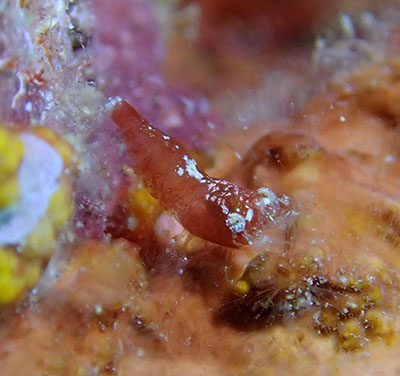 Damaris Torres-Pulliza
Damaris Torres-Pulliza |
|
Thorella
or
Thor sp.
Damaris Torres-Pulliza found several of
these at night off the north shore of O'ahu. She writes: The animal
was about 7mm in size and I believe there were more than one, but
these were very 'jumpy' and hard to keep track of." Dama sent
photos to two shrimp specialists and received two answers:
"The shrimp
may represent a species of Thorella, a genus being presently
monotypic (type species: T. cobourgi Bruce, 1982). It is possible
that unknown species of the genus still await discovery.-- Dr. Tomoyuki
Tomai.
"These
reddish specimens might be another species than Thor paschalis,
perhaps even new to science" -- Dr. Charles Fransen.
Whatever it
is, Dama seems to have found something new! .
|
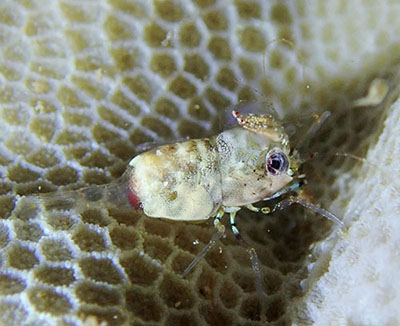 Damaris Torres-Pulliza
Damaris Torres-Pulliza |
|
Thor leptochelus
Xu & Li, 2015
Family Thoridae
Damaris Torres-Pulliza and Roney Rodrigues
found this unusual shrimp at night off O'ahu's north shore at a
dapth of about 7 m. Dama writes: "This shrimp was the funniest
to watch, one that would make you laugh through your regulator -
it moved very awkwardly and erratically. With its bottom half legs
and abdomen transparent, it looked like a spider walking on stilts.
On site it appeared to mimic Pagurixus nomurai hermit crab,
at least that's what I thought at first." Searching the internet,
she found a paper
that described something very similar. She wrote to the authors
and received this reply:
Dear Mrs. Damaris Torres-Pulliza, Thank you for your interesting
news. Yes, your shrimp closely resembles Thor leptochelus,
as you suggest. As far as I know, the species has not been recorded
from Hawaii.... Best wishes. Tomoyuki Komai
|
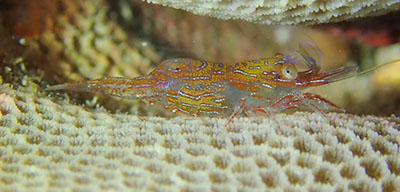 Damaris Torres-Pulliza
Damaris Torres-Pulliza |
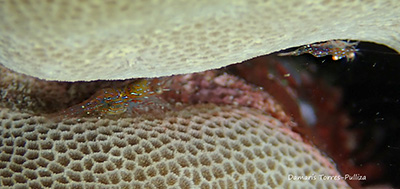 Damaris Torres-Pulliza
Damaris Torres-Pulliza |
|
Thor spinosus
Boone, 1935
Family Thoridae
O'ahu diver Damaris Torres-Pulliza found
two of these tiny shimps inhabiting a crevice in a head of Porites
lobata coral and was able to visit them multiple times. One
was smaller than the other. She sent her photos to shrimp specialist
Dr. Charles Fransen in the Netherlands. He replied with the ID above.
He also mentioned that he knew of only one other photo of the species,
so it appears that Dama's photo of this beautiful shrimp is also
quite rare! The species is known from East Africa to Hawai'i and
French Polynesia. The one in the top photo looks to be about 2 cm.
long (about .75 inch).
|
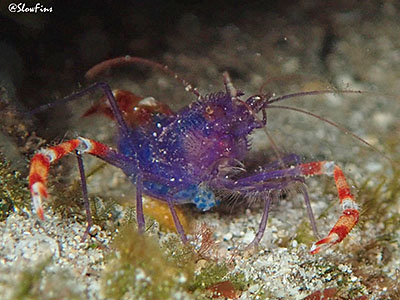 Roney Rodrigues
Roney Rodrigues |
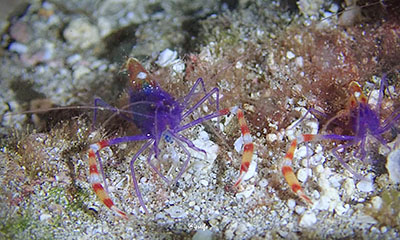 Damaris Torres-Pulliza
Damaris Torres-Pulliza |
|
BLUE CORAL SHRIMP
Stenopus tenuirostris
de Man, 1888
Family Stenopodidae
Roney Rodrigues and Damaris Torres-Pulliza
made an exciting find when they photographed two pairs of these
shrimps off West Oahu in June, 2021. As far as I know, the species
has never before been recorded from Hawai'i, though it ranges widely
in the Indo-Pacific from East Africa to the Marquesas Islands in
French Polynesia. The two pairs were about 100 ft. apart at a depth
of about 40 ft. Blue eggs are visible under the abdomen of at least
one of them, so they do seem to be reproducing here. Reports of
additional sightings would be welcome
UPDATE: October, 2022. Pam Madden found a pair at 80 ft. in Kona
off the Big Island, and shot some great video.
Pam's sighting is the first record from the Big Island, as far as
I know.
UPDATE: Susan O'Shaughnessy discovered another pair at Pu'u Olai,
Maui in February 2023, and Pauline Fiene took some gorgeous photos.
See them here. Susan
writes: "They are in about 45 ft of water.... The eel is there
most of the time. There is a pair of Lysmata amboinensis residing
in the same tunnel as the Stenopus tenuirostris and the undulated
moray under the coral. There are two Stenopus hispidus up on top
of the rock and several Saron marmoratus in the coral head. It is
interesting for so many species to be in proximate habitats."
Susan's find is the first record of the species for Maui as far
as I know.
|
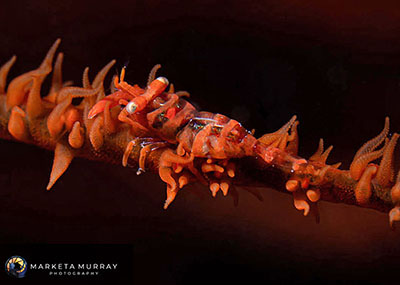 |
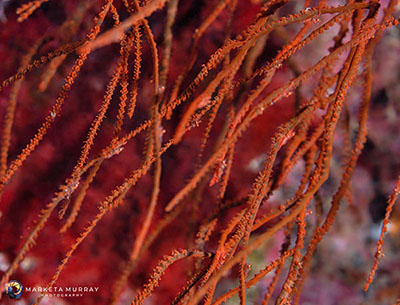 |
|
HAWAIIAN BLACK
CORAL SHRIMP
Pontonides
sp.
Family Palaemonidae
Marketa Murray photographed these
small shrimps on Hawaiian Black Coral Antipathes griggi at
a North Kohala dive site in October 2020. The depth was about
40 ft. Although they resemble the Barred Wire Coral Shrimp Pontonides
ankeri, which lives in pairs on Wire Coral Cirrhipathes anguina
and Red Wire Coral Stichopathes sp., Marketa's shrimps
live in colonies of perhaps hundreds of individuals and on a quite
different host. They likely represent an undescribed species, very
probably in the genus Pontonides and perhaps endemic to Hawai'i.
Specimens have been collected and await examination by specialists.
These shrimps have also been photographed on black coral off Maui.
Reports of other sightings would be welcome.
|
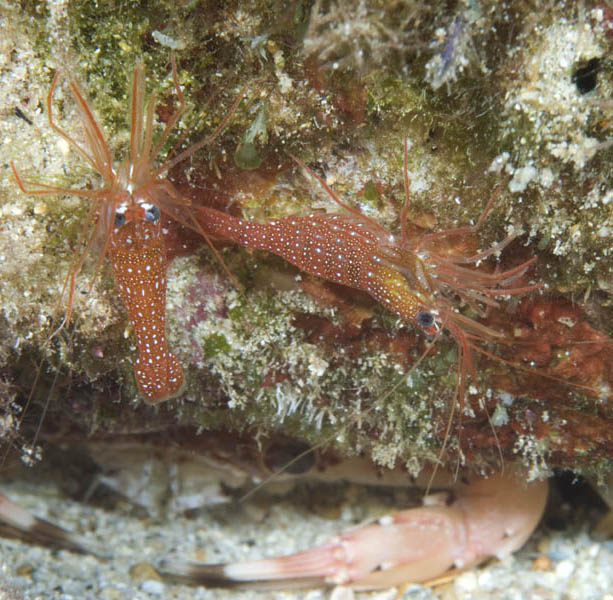 |
|
STARRY CLEANER
SHRIMP
Lysmata acicula? (Rathbun, 1906)
Family Hippolytidae
A photo of this shrimp appears in Hawaii's
Sea Creatures
on p. 235. In earlier printings it was incorrectly identified as
Lysmata ternatensis. Recent photos of the real L. ternatensis
show a striped shrimp, not a spotted one. Obviously, then, this
is something else. I sent the photos to Dr. Sammy de Grave of Oxford
University, who thinks that it is probably a species originally
described by zoologist Mary Jane Rathbun in 1906 from 4 specimens
found under a tugboat in Honolulu and one specimen dredged off Kauai.
Rathbun named her shrimp Hippolysmata acicula. Unfortunately,
as was typical in those days, she did not note the color of the
live animal. In 1997 Rathbun's specimens were examined by zoologist
Fenner Chace of the Smithsonian, who declared that H. acicula
was the same as Lysmata ternatensis, a species from Indonesia
that had been described and named several years earlier, in 1902.
However, the museum specimens Chace examined were bleached and devoid
of color. Now that photos of the living animals are available, it's
clear that the species pictured here and in my book is not ternatensis.
However, to prove that these Hawaiian ones are indeed Rathbun's
acicula (or possibly something else), several need to be
collected, photographed, and examined. Unfortunately, they are very
rarely seen. If you find these shrimps anywhere, please let me know.
Specimens needed! (Thanks to Dennis McCrea and Debra Newbery for
finding this pair and showing them to me! Debra has taken some terrific
video of these shrimp interacting
with a Banded Coral Shrimp, Stenopus hispidus, and an unidentified
portunid crab.
Update: In December
2010 Dennis McCrea found and collected two of these rare animals
and sent them to Dr. de Grave, who is in the process of determing
whether they are Rathbun's acicula or a new species. Meanwhile,
I have made bold and changed the name in my book to L. acicula.
|
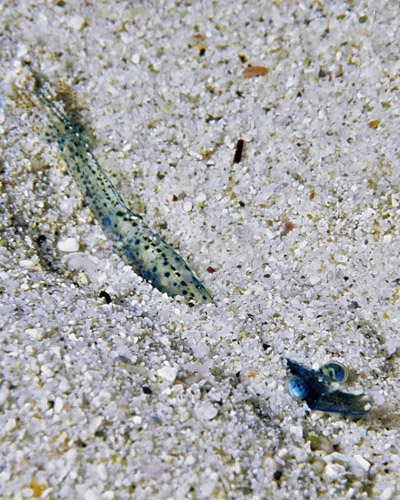 |
|
UNIDENTIFIED
Metapenaeus? sp.
Family Penaeidae
Paul
Okumura took this photo of a sand-dwelling shrimp in Kona off "Mile
Marker Four" on Alii Drive at a depth of about 40 feet. I sent
the photo to Dr. Tin-Yam Chan in Taiwan, who answered:
Your
penaeid photo does not show much as the shrimp is burying in sand.
I am sorry that I can not identify it positively, though it is likely
a Metapenaeus judging from coloration (there are many species
in Metapenaeus and their coloration are very similar). But
juvenile of Penaeus s.l. and some Metapenaeopsis sometimes
also with this green body and dotted coloration.
The Bishop Museum
records only one species in the genus Metapenaeus as occurring
in Hawaii: Metapenaeus affinis. So that is one possibility.
I was impressed by the blue-green coloration, as sand-dwelling shrimps
of this sort that I have seen before have all been reddish. However,
shrimps that are reddish at night are sometimes bluish or greenish
by day, and Paul took this photo in the late morning.
|
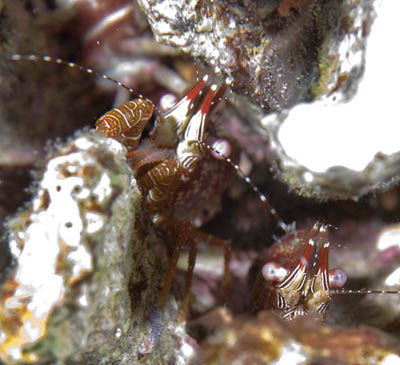 |
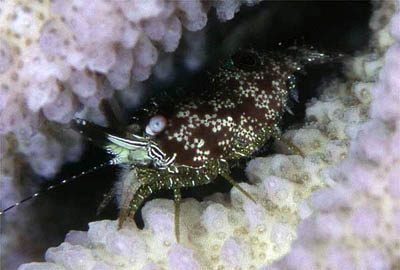 |
|
EYESPOT SHRIMP
Saron neglectus
De Man, 1902
Family Hippolytidae
A photo of this shrimp appears in
Hawaii's Sea Creatures on p. 233, photographed out of its natural
habitat but clearly showing the two dark "eyespots" on
the upper rear of its carapace. The photos above show the shrimp
as it appears in its natural habitat, with eyespots out of sight
or barely visible (as on the shrimp in the bottom photo).
According to Japanese shrimp expert,
Dr. Junji Okuno, an almost identical Saron shrimp that lacks
false eyespots has also been identified as Saron neglectus.
That shrimp is widespread in the Indo-Pacific, but absent from Hawaii.
If the "eyeless" shrimp turns out to be the true neglectus,
then the species pictured above could be un-named. The uncertainty
is probably due to the original neglectus having been described
from colorless museum specimens. Dr. Okuno has compared the two
and has found no significant differences except for the color pattern.
|
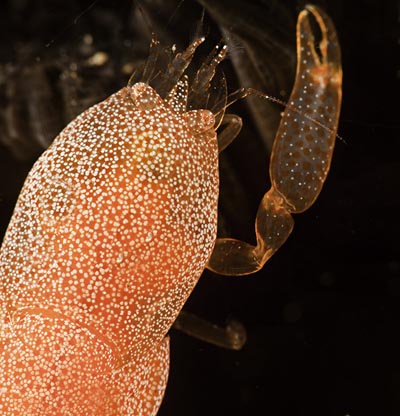 |
|
PEARL OYSTER
SHRIMP
Conchodytes meleagrinae Peters, 1852
Subfamily
Palaemoninae
Shine your dive light into a Blacklipped Pearl
Oyster, and quickly, before it closes its valves, you just might
catch a glimpse of one of these fat little commensal shrimps. They
live inside these oysters, probably never leaving their host. Although
I mentioned this shrimp in my book in the pearl oyster writeup,
I misspelled the scientific name as Conchodytes meleagris.
(This has been corrected in the latest printing.) The American Fisheries
Society has given it the official common name "Hawaiian pearloyster
shrimp," which makes little sense because the species is widespread
in the Indo-Pacific. David Fleetham grabbed this rare photo off
Kaanapali, Maui, at a depth of 40 ft. Visit Dave's website at http://davidfleetham.com/
|
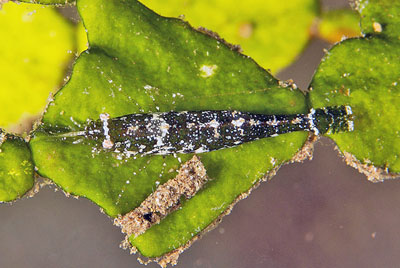 |
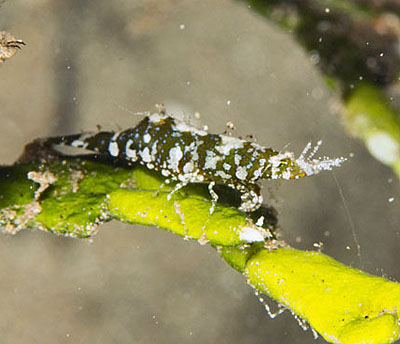 |
BIGNOSE
HALIMEDA SHRIMP
Latreutes pymoeus Nobili, 1904
Family Hippolytidae
L. pymoeus lives on sea grasses, Halimeda,
and perhaps other types of algae throughout the Indo-Pacific. It varies
in color from brown to green, often with lighter spots and markings
and grows to about 3/8 in.. The large rostrum can vary somewhat in
shape. As far as I know, this species has not been officially recorded
from Hawai`i, but in 2011 Cory Pittman sent specimens from Maui of
what appears to be the same shrimp to Alain Crosnier in Paris, who
identified them. Ralph Turre took the photos off Sugar Beach, Maui,
at night. Depth 20-25 ft.
|
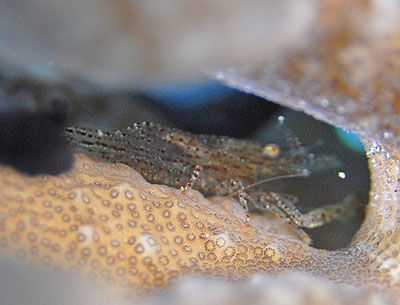 |
|
STARRY CORAL
SHRIMP
Harpiliopsis beaupressii
(Audouin, 1825)
Subfamily Pontoniinae
I found several of these in a head
of Cauliflower Coral (Pocillopora meandrina) at Ho`okena,
Hawai`i at a depth of about 20 ft. They were difficult to photograph
as they kept moving out of sight around the coral, and this is the
best I could do. I had never seen the species before, and have not
found it since. The shrimp has a wide Indo-Pacific distribution,
from Africa to Easter Island, and always associates with branching
corals (Pocillopora, Seriatopora, Stylophora, rarely Acropora).
|
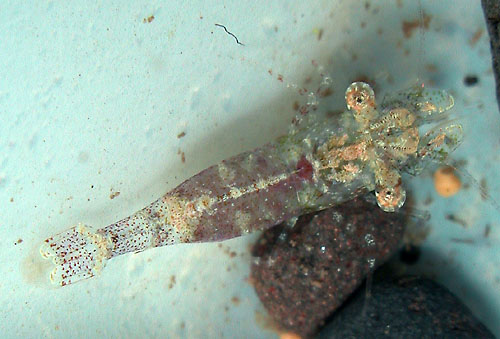 |
|
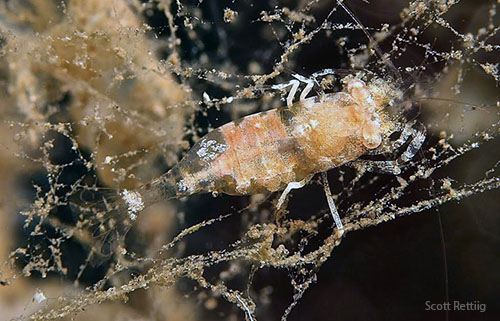
EASTER SHRIMP
Thor paschalis (Heller
1862)
Family Thoridae
Crazy name--why "Easter"??
Who knows, but that's the meaning of paschalis, the Latin
species name. Likely the shrimp was discovered or named on Easter
Sunday. It is only about 1/4 in. long, thus rarely noticed. It belongs
to the genus Thor, which has only five known species. Thor
paschalis is widespread in warm seas throughout the Indo-Pacific
but little else seems to be known about it. The animal in the top
photo was collected by Cory Pittman off Maui and sent to Dr. Alain
Crosnier in Paris for identification, so the ID is sound. The bottom
photo was taken by Scott Rettig at South Point, Hawai`i. I am guessing
that the two are the same species, but examination of a specimen
by a specialist would probably be necessary to confirm this.
|
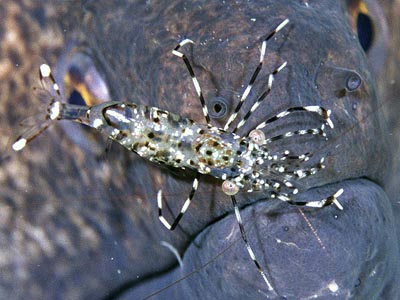 |
|
Urocaridella
sp.
Subfamily Palaemoninae
According to Dr. Junji Okuno, an expert
on shrimps of the genus Urocaridella, this species has not
yet been named or described. It occurs from Hawai`i to the Western
Indian Ocean and is similar in appearance and habits to the Clear
Cleaner Shrimp Urocaridella antonbrunii on p 222. of Hawaii's
Sea Creatures. I photographed it during the summer of 2005 at Makua,
O`ahu, at a depth of about 45 ft. The eel is a Yellowmargin Moray,
Gymnothorax flavimarginatus. (I have added this photo to
the revised April 2010 printing of Hawaii's
Sea Creatures.)
|
 |
|
Exocliminella
maldivensis Duris & Bruce, 1995.
Subfamily Palaemoninae
Mike
Roberts photographed this beautiful little shrimp off Maui,
at a depth of about 40 ft.. The ID was confirmed by Dr. Junji Okuno
in Japan. Mike's photo is the first I know of from Hawai`i, though
the shrimp appears to occur throughout much of the tropical Indo-Pacific.
Mike says that the bright colors, esp. the blue, help him find these
shrimps, which are very secretive and live in rubble. The first
Hawaiian record of this species was made by researchers from the
Bishop Museum, who collected it on the Atlantis wreck off Waikiki
in 2001. Size of specimens in the original description was 12-16
mm., or around 1/2 in. (I have added this species to the 2014 printing
of Hawaii's
Sea Creatures.)
|
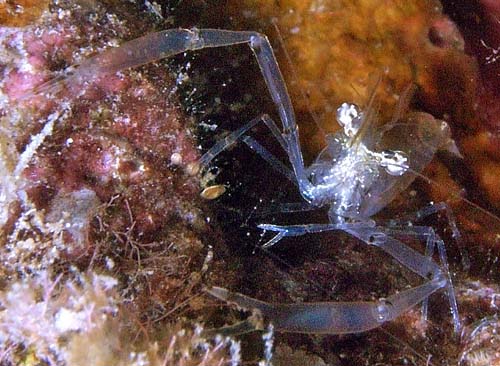 |
Cuapetes
grandis ? (Stimpson,
1860)
Subfamily Palaemoninae
Katie Samuelson photographed this shrimp at
Pupukea, O`ahu, (Sharks Cove) at 15 ft. I subsequently collected a
specimen that looked much like it and sent it to Dr. Alexander Bruce,
at the Queensland Museum. He identified my specimen as Cuapetes
grandis (formerly Kemponia grandis or Periclimenes grandis),
which has been recorded from Hawaii a number of times. However, the
shrimp in Katie's photos could also be C. elegans (also recorded
from Hawaii). Dr. Bruce would have to examine a specimen to be sure.
Mike Roberts photographed what appears to be the same species at Ulua
Beach, Maui, (see below). The white line between the eyes is distinctive
of this group. (I have added this species to the 2014 printing of
Hawaii's
Sea Creatures.) |
 |
|
Cuapetes
grandis? - photos above and below copyright 2007 by Mike
Roberts
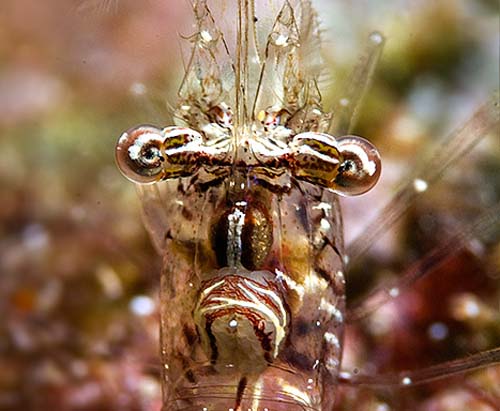
|
|























